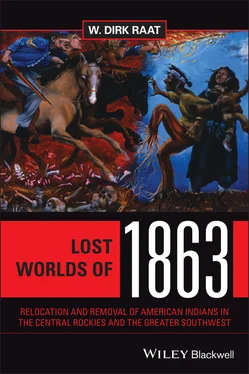The Paiute perspective of the event, as told by Sarah Winnemucca, differs from the official explanation. Her account was later substantiated by Numaga at a peace conference at Fort Churchill. First, as Numaga reported, with the exception of three or four men in the camp, all the dead were women and children. The cattle thieves had evidently left before the arrival of Well’s volunteers. Some women who tried to escape jumped into the water and were drowned, while others were shot while in the lake. The infants and babies that were still tied up in their baskets were burned alive as the camp was set on fire. At least two of Old Winnemucca’s wives were killed, including Sarah Winnemucca’s mother, Tuboitony. 78
Finally, to speculate a bit, many Nevada volunteers had served time in Utah under General Connor’s command and were later transferred back to Nevada. 79It is likely that some of them knew of the Bear River Massacre of 1863 (see Chapter 8) and the follow-up campaign against Chief Pocatello, and were imbued with the kind of hatred that such actions produced. It is little wonder that the young and inexperienced officers with volunteer soldiers would take the cries for extermination literally, and while so doing make a name for themselves. As for Old Winnemucca, he would pursue his own spiritual quest in the Steens Mountains. After the Mud Lake massacre he, and many of his followers, refused to return to Pyramid Lake. 80
Throughout the end of the 1860s the Northern Paiutes of Pyramid Lake and western Nevada had several concerns. Violence and conflict with whites was one of them, especially in 1866 after the soldiers shot “everything that wore paint” at Rock Canyon, north of Pyramid Lake and east of the Modoc area, killing 80 Indian men and 35 women.
A more persistent problem was the activity of Indian agents on many of the “de facto” reservations, including the Pyramid Lake Reservation. They often refused to give out rations, engaged in illegal transactions then arrested and sometimes killed the Indians for engaging in illegal acts, refused to educate their children, and most of all, they would not protect the Paiutes from white encroachments. In 1868 measles killed over 100 Pyramid Lake Paiutes while the agent did nothing to aid the sick Indians (similar numbers died at Walker Lake due to typhoid fever and consumption). By mid-summer hatred of the Indian agent led many citizens of Pyramid Lake to abandon the Paiute reservation and wander to other areas, including Camp McDermit in northern Nevada immediately south of today’s Oregon border. In July Old Winnenucca and 490 Paiutes came into Camp McDermit, and by the end of the year there were more than 800 Paiutes that were allocated food. There hopefully they could join the Quin River Paiutes and some Bannocks, and find a sanctuary from reservation agents at a military installation where the army would issue rations to them. 81Yet many Paiutes, especially women, still worried about living too close to the white man.
One concern, strange to say, was cannibalism. Most whites suspected that the savages were cannibals, but in this case it was the Paiute who was concerned about the cannibalistic whites. As early as the spring of 1847 Captain Truckee and the Paiutes learned of the fate of the Donner Party in which the desperate snowbound group of whites turned to eating themselves as well as their Indian guides. The Paiutes became convinced that the whites not only killed people but ate them. 82
As a child Sarah Winnemucca’s mother, Tuboitony, told her that the whites were killing and eating people. When some whites were spotted her aunt told her mother, “Let us bury our girls [Sarah and her cousin], or we shall all be killed and eaten up.” 83As an adult Sarah remembered that her father, Old Winnemucca, had called the whites “owls,” conjuring up the image of the Cannibal Owl, a Paiute boogeyman who, according to ancient tales, carried away misbehaving children and ate them. 84
The Owens Valley Paiutes knew about Panatűbiji’, the Indian who experienced the cannibalistic acts of one of the first white men to enter the Valley. The stranger took Panatűbij’ to the body of a corpse, proceeded to cut off both legs, and returned to the camp near Soldiers’ Pass where he brewed up a stew pot. At dark the white man satisfied his hunger by eating the human stew. As for his Indian hosts, they refused the stew and left the camp to hide in the caves of the mountains. 85So, as can be seen, in the history of Indian–white relations it was not always clear who was and was not the savage cannibal!
At Camp McDermit another concern for the Paiute women was fear of rape and sexual violence by white men. Molesting Indian women was typical of life around military installations, and Camp McDermit was no exception. Sarah Winnemucca, who spent her entire life fearing rape by white men, got the military commander to declare the Indian camp off limits to both settlers and soldiers. 86
As a youngster she and her sister were taken to a camp in San Joaquin, California. There, after Truckee had left his grandchildren to go to the mountains, hired hands working for the ferry would assault her sister. In Sarah’s words, “The men whom my grandpa called his brothers would come into our camp and ask my mother to give our sister to them. They would come in at night, and we would all scream and cry; but that would not stop them.” 87Captain Truckee was unaware that in California Indian women were often seized and forced to serve as concubines. 88Later on a major cause of the Bannock War of 1878 was the rape of a Bannock girl who had been out digging for roots (similar to the catalyst of sexual violence involving young girls prior to the Pyramid Lake War). 89
In the late 1860s, the Paiutes at Camp McDermit were encouraged to go north to Fort Harney in south-central Oregon (McDermit would become a reservation in 1889 with some Paiutes receiving allotments a few years later). By this time the wandering Paiutes favored military posts over government reservations, so several Paiutes traveled to Fort Harney. By 1872 the Malheur Reservation, immediately east of Fort Harney, was established by executive order, and now the Paiutes were encouraged by Agent Samuel B. Parrish to settle there. Unlike many other Indian agents, Parrish, although not particularly religious, was a humane man who told the Paiutes that the reservation belonged to them and they would no longer be working for the agent. Winnemucca and his group, along with Chief Egan (Ehegante) and his followers (Egan was born a Cayuse, adopted as a Paiute, and eventually became leader of an Oregon band), went to Malheur. There by 1875 they had succeeded in digging a two-mile ten-foot-wide irrigation ditch, clearing and planting 120 acres, and building a schoolhouse. 90It appeared that some of the wanderers had found a home.
Alas, the good life was not to last. First, the fine citizens of Canyon City, a mining town a short distance from the northwestern corner of the reservation, had petitioned the Office of Indian Affairs. Evidently, the governor of Oregon and others asserted that the Paiutes had no claim to the western side of the reservation, and that the Harney Lake basin and nearby meadows should be used by cattlemen and not Indians. Then, in 1876, Parrish was removed ostensibly because he was not a practicing Christian and religious societies, like Mormons and Methodists, were to manage the reservations for the Indian service. Enter practicing Christian William V. Rinehart, an ex-miner and Indian fighter who, unlike Parrish, could not be accused of “soft-heartedness” toward the Indians. Not humane like Parrish, he was a man of violent temper who regarded Indians as the enemy. His major goal was to push the Paiutes out of Malheur and allow the whites to encroach on what was once their newly promised land. After the harvest of 1876 when the deduction of past expenses for rations and clothing left the Numu with very little pay, Egan and the others knew that Rinehart was purposely pushing them out of the Malheur Reservation. Some went to Fort Harney, while others followed Old Winnemucca to the Steens Mountains south of Malheur Lake. 91
Читать дальше












